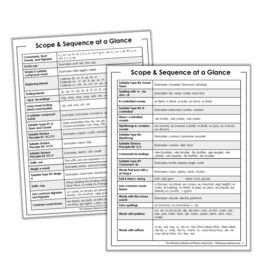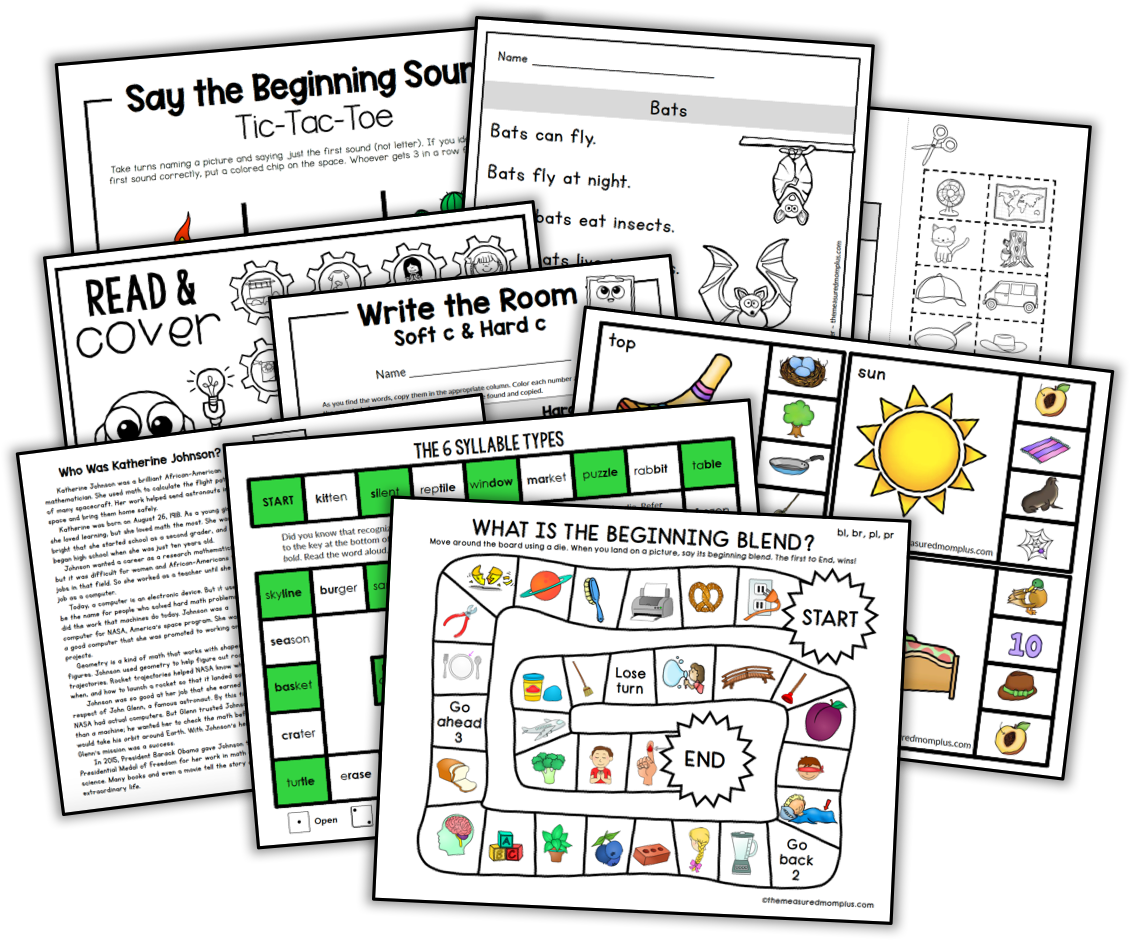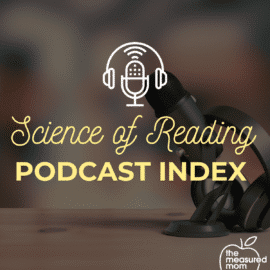In today’s post, the second in our 5-part series, we’ll dive into do’s and don’ts for teaching phonics.
Another name for this post could be “Mistakes I’ve Made When Teaching Phonics …” because I’ve made a lot.
(Psst… I’m sharing a free phonics scope and sequence at the end of the post!)

Let’s start with a little backstory.
When I first started teaching first grade, I had to use a very rigid phonics program that I detested.
I was a balanced literacy teacher all the way, and I didn’t think that such a structured approach was necessary. (Also, to be fair, the program was very, very boring and took an insane amount of time.)
The following year, I chose (with the principal and school board’s blessing) to take a different approach to phonics instruction. I taught phonics on as “as you need it” basis and taught my students to read using leveled texts and the three cueing system.
When students were stuck on a word, I did as I’d been taught in graduate school and tried really hard not to say, “sound it out.” Instead, I told my students to use clues from the picture or sentence to help them “solve” (note that I didn’t say read) the challenging word. I asked them to connect what they saw in the picture with the first letter of the mystery word.
I wasn’t anti-phonics by any means; I felt I was teaching as much of it as my students needed. But I put a greater emphasis on three-cueing; I thought that using three cueing was teaching them to problem solve.
Now, after studying the science of reading, I understand that students need to learn phonics in a structured way so they can become proficient at orthographic mapping and, thus, learn to read words by sight.
Learning to read words by sight is not about memorizing lists of “sight words”; rather, it’s about connecting phonemes to graphemes (sounds to letters) until it becomes automatic.
Orthographic mapping involves the formation of letter-sound connections to bond the spellings, pronunciations, and meanings of specific words in memory. It explains how children learn to read words by sight, to spell words from memory, and to acquire vocabulary words from print.
Linnea Ehri
Now that you know a bit of my history, let’s dive into the do’s and don’ts for phonics instruction.

As a first and second grade teacher, I had a general idea about the order in which to teach phonics skills, but I didn’t think it was all that important.
I never had a printed scope and sequence that I could refer to.
Now I understand that a solid scope and sequence is KEY.
According to Wiley Blevins, in his fabulous book A Fresh Look at Phonics, a superior scope and sequence will:
- Build from the simplest to the most complex skills
- Allow many words to be formed as early as possible
- Teach high-utility skills before less useful sound spellings
- Separate easily confused sounds and letters
A solid scope and sequence is a road map, and it’s essential for anyone looking to teach phonics in a structured, systematic way.
If you’re looking for the perfect scope and sequence, I’m sorry – there isn’t one. But following the above guidelines will help.
As I take into account my experience, study, and Orton-Gillingham training, I now recommend the following sequence for phonics instruction:
- Consonants, short vowels, and basic digraphs (ch, sh, th, wh) … with CVC words
- Beginning and ending blends
- CVCE words
- Long vowel teams
- R-controlled vowels
- Diphthongs and complex vowels
- Less common sound spellings
Of course, there’s a lot more that needs to go into that sequence, such as syllable types and spelling rules.
You can grab my full scope and sequence for phonics instruction for FREE at the end of this post.

I fought decodable texts for a long time. That’s probably because the ones I had to use were just awful. They were stilted and nonsensical. I just couldn’t stomach them.
Instead, I used leveled texts. I thought that students were building fluency because they could “read” these books quickly, but they weren’t truly reading. They were using context and perhaps the first letter or two to guess the words. Occasionally they were sounding out words in their leveled readers. And as their haphazard phonics knowledge grew, some students naturally used phonics more and more. Eventually, they were truly reading.
But not all of them.
Some of them were still guessing. And I didn’t realize that because I didn’t see them when they graduated from my room into third grade. I didn’t see them struggling through harder texts – texts with fewer pictures and longer words – when three-cueing no longer served them.
Students must practice what they’re learning in their phonics lessons by reading connected text. This text may be decodable passages or decodable sentences, but I think using actual decodable books is a good goal.
Here’s why:
- It’s exciting to read an actual book. It’s fun.
- Books tell stories (or at least they should). Stories are fun.
- Books have pictures (or at least they should). Pictures are fun.
No, learning to read isn’t all about fun.
But I feel I need to add the “fun” bit because sometimes it gets lost in the structured literacy approach. I get discouraged when I hear people say that early reading material shouldn’t have any pictures.
As long as our phonics material is structurally sound, there’s nothing wrong with making it appealing. Learning to read is hard work, but stories and pictures add joy.
As for where to find these quality decodable books, you’re in luck.
I spent six months purchasing and studying decodable texts. You can find my top recommendations in this post.

This morning I remembered how important routines are.
That’s because today was the first day all six of my kids went to school – from my oldest in high school all the way down to my baby, on his first day of kindergarten.
In order to get all the kids out the door at 7 AM, pick up two neighbor girls, and get to both schools on time, a routine was absolutely essential.
And we were out the door with five minutes to spare!
As a mom, I’ve learned how important routines are.
For some reason, though, I fought routines as a classroom teacher. I felt that routines made things boring.
As a parent I see that routines give kids security. They know what to expect. They get better and better at doing the things because they’ve done them so many times.
A routine helps you do the easy stuff automatically; it frees up your brain for the challenging work.
All that said, here’s a good routine for your phonics lessons.

These phonics lessons don’t have to be for the whole class.
I find it interesting (and frankly, disheartening) that some structured literacy teachers are adamantly against small group lessons. They maintain that the best (and only) way to teach phonics is through a whole class approach.
This way everyone gets access to grade level material.
But how does a 30-minute phonics lesson on “grade level” material help the student who is miles behind? And what does it do for the advanced readers who knew this content last year?
This is where small group teaching comes in, and it brings us to our first DON’T.

I know that one reason I had such a negative feeling about structured phonics lessons was because the whole class lessons I taught that one year served very few of my students.
It was a class of about 20 first graders, and several of them entered the room reading fourth grade chapter books.
I also had a student who had spent two years in kindergarten and still struggled to remember letter sounds.
The rest of the kids were spread across the middle.
A single phonics lesson was supposed to meet ALL of their needs?
I wish I had thought of giving a phonics assessment and then grouping my students by phonics skill.
Instead, I grouped by “reading level” and had my students read leveled books.
When some students got stuck at a lower level, I didn’t realize it was probably because they needed more explicit phonics instruction … not more practice with three-cueing.
In an ideal world, you’d have other teachers in your building who would work with you so that each of you could teach a small group phonics lesson at the same time. Students would visit a different classroom if needed, and each would get instruction tailored to his/her needs. In just 20-30 minutes, every student would be done with his/her phonics lesson.
In an ideal world.
I have never lived in that world, and you may not, either.
Here’s my recommendation:
- Give a phonics assessment (if you’re a member of my course, Teaching Every Reader, you can use the one in this lesson).
- Group your students by what they’re ready to learn next. Have no more than 4 groups, even if it means (and it probably will) that some students will need to start by practicing things they already know.
- Train your students to do meaningful literacy activities while you’re meeting with small groups. Yes, this will take some time. Yes, it will be worth it.
- If possible, meet with all of your phonics groups each day. If it’s not possible, make sure you meet with your lowest groups daily.
- Within your groups, follow the structure of an effective phonics lesson, as noted in the above infographic. Your lower groups will likely need longer lessons than your highest group.

A common criticism of structured literacy/the science of reading is that it’s all about phonics.
I feels like that.
It feels like that because other approaches often lack an appropriate focus on phonics, so the structured approach may feel like it’s going a little overboard to correct it.
The fact is, phonics instruction is HUGE for beginning readers. Decoding is the bulk of their reading work.
As they become more proficient at decoding, they will become more fluent, and they will be able to devote more attention to reading comprehension.
But they need to become proficient with phonic decoding first.
AND YET …
Beginning readers can (and should) build background knowledge.
They can (and should) build vocabulary.
They can (and should) think critically.
They can (and should) learn about language structures, genres, and more.
If you’re a student of the science of reading, you’re likely familiar with Scarborough’s reading rope, which you can see here.
Dr. Hollis Scarborough published it in 2001 as a visual to illustrate the complexities of learning to read.
As you notice, there are two strands. The top strand involves language comprehension.
The bottom strand is where phonics comes in.
What we need to remember is that those early decodable books aren’t going to do a whole lot to improve language comprehension.
The bulk of that work comes through interactive read-alouds.
I recommend doing one or two interactive read-alouds every day. You can learn more about them in this blog post.
Let’s sum up!
This was a hefty blog post about teaching phonics! Let’s review.
DO follow a strong scope and sequence when teaching phonics. As a reminder, you can get my scope and sequence for FREE at the end of this post.
DO use decodable texts. It’s true; many decodable books have given them a bad name. But they’re not all boring and stilted; in fact, better books and series are being published all the time. Check out my ultimate guide to decodable books to find the best of the best.
DO follow a consistent routine in your phonics lessons. When kids have a routine for the easy stuff (knowing what comes next, getting out their letter tiles, etc.) they free up their brains for the more challenging work. A routine also keeps the teacher on task and makes planning easier!
DON’T limit your phonics instruction to whole class teaching. If all of your students have the same level of phonics knowledge, go ahead and stick to whole class teaching. But I’m willing to bet that they’re all over the map. Focused small group lessons will accelerate student growth.
DON’T forget the rest of the Reading Rope. Phonic decoding is extremely important for beginning readers, but we can address other strands through interactive read alouds.
CLICK HERE FOR A PRINTABLE VERSION OF THIS BLOG POST
Free phonics scope and sequence

Free Phonics Scope & Sequence
Check out the rest of this series!
Part 1Part 2Part 3Part 4Part 5





Allie
Thank you so much for the information! I can’t seem to download the Scope & Sequence. When I click the link, it goes blank. Could you email it to me?
Heather Groth, Customer Support
Hello Allie! When you click the link, there should be a pop-up that appears asking for your name and email address for the Scope and Sequence to be emailed to you. Is there a chance that you’re using an ad-blocker or pop-up blocker that won’t let that sign up page come up? You may want to disable it and then try again. If you’re still unable to access it, please email us at hello@themeasuredmom.com and we will continue to help!
Amy
Anna, I enjoyed reading your Phonics bit. I am an ELL aide and I have been doing phonics for years, including a lot of what you’ve been talking about. Right now I’m between 2 schools and I serve ALL grades. The difference between class size and instruction of them is like night and day. The most in one class at one school is 17 while the other is 28. Kids are so diverse these days that teacher directed individualized instruction at one of those schools is impossible. I know that with staffing shortages, we’re struggling…I was one of those kids who brought in chapter books to read in 2nd grade, but I was lucky, my parents had been teachers. Now it’s lucky if a student sees their parent before they go to bed. There is NO SUPPORT at home and we have to shoulder the brunt of it.
I, unfortunately have no real say as to what is used for instruction, so cannot purchase anything for instruction, but do use some freebies that you have occasionally.
Thank you.
Anna Geiger
Thank you so much for all that you’re doing, Amy! It can feel so hard to make a difference when your hands are tied, but I know that what you’re doing is so important!
Heather
But for the few that you can rescue, it’s worth it! I taught 8th grade ESE LA, which meant way too many were on their way out the door even before the year ended, simply because they were turning 16. However, I invested extra time in sitting with the few who were still willing to try. If they just learned -sion/-tion sound, think of how many words they’d add to working knowledge! Don’t ever give up- little tricks will help ELL’s too, though we don’t get to do all we’d like!
Glen
Correction to the above comment.
Excellent, for anyone who wants to teach in a sequential manner so the learner learns to connect auditory and visual in a systematic manner.
Glen
Excellent for anyone who wants to teach in a sequential manner so the learner can connect auditory visual is connected in a systematic manner.
Dwight Zirschky
I’m sorry but using the 3 cue system only teaches students to be poor readers. Take the time to teach letter sound correspondence and and phonetic skills and don’t be in a hurry to shortcut to what appears to be “reading”.
Anna Geiger
Did you read the whole post? I agree with you.
Mary Bracy
Anna! I just want to say what a truly wonderful person you are! You give and give and give! The humility with which you lead others to find scientifically proven best practices is truly inspiring. I have benefitted so much from reading your blogs and using your materials! I hope God continues to bless you, your family, and all your hard work!
Anna Geiger
You are very kind, Mary! I don’t deserve all that praise, but I very much appreciate the encouragement!
Cindy
Excellent! Can you please tell me how I can get a copy of “The Structure of an Effective Phonics Lesson” poster?
Anna Geiger
I don’t have it as a pdf, but you can right click, save as image, and then print the image. 🙂